Working with found objects, industrial materials, and traditional media, Victoria Fuller has been creating attentive and mischievous installations and sculptures that investigate issues of power, environmental concerns, and current strategies in appropriation for over two decades. Last month The COMP Magazine visited Fuller’s West Hubbard Street studio to discuss her use of everyday objects, her recent installation at Waubonsee Community College, what she values most in her art practice, and her current projects being developed for exhibition in 2017.
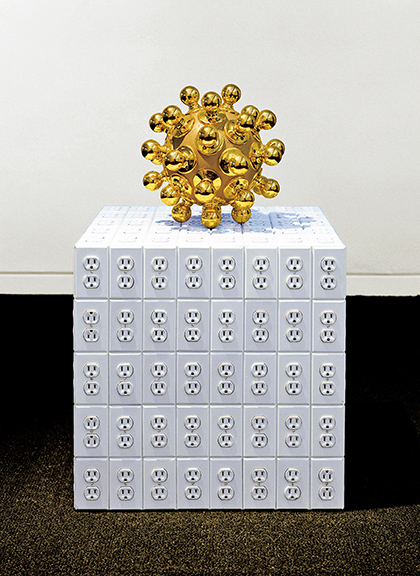
Victoria Fuller, Knob Job and The Power Box, 2001
Wood, doorknobs and sockets, Box: 23″ x 23″ x 23″, Ball: 13″ diameter
Wow, you and I have known each other for the better part of 20 years? I’m curious if you will share with us a bit of your background? Are there any early events or people who you see as having an impact on your current aesthetic investigations?
The pediatrician that my mom took me to as a child had an art studio attached to her office. She used to take me in there to look at her art and gave me one of her watercolors. I still treasure it. At an early age I also took a trip with my class to Philadelphia where we saw paintings of John Singer Sargent, and The Dutch Masters. I was blown away by their precision and beauty. In high school I was exposed to the work of MC Escher, Georgia O’Keefe, Joan Miro, Cubism, paintings of Francis Bacon, and Surrealism. In college I was exposed to the work of Marcel Duchamp, Dada, Constantine Brancusi, and the Pop Art movement of the 60’s.
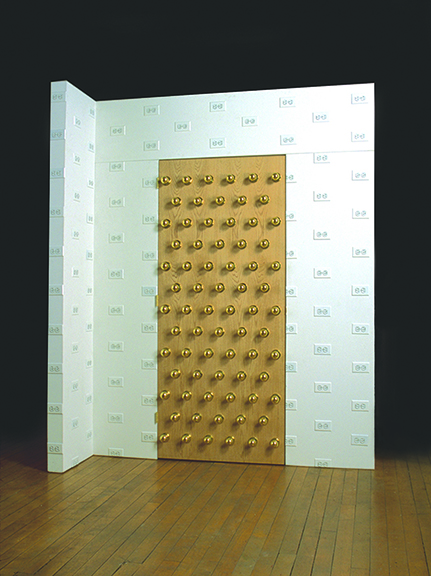
Victoria Fuller, Wall of Excess and Indecision, 2001
Door, wall, doorknobs and outlets, 84.5″ x 102″ x 24.75″
What was the impetus for the series Electrical Found Object Works? Can you offer insight into the theoretical and tactile aspects of these works?
In the manner of Marcel Duchamp’s Ready-Mades, I use common everyday objects, as building blocks to make abstract forms and designs. Because everyday objects serve a function in our world, one can also imbue them with symbolic or metaphorical content, based on what these things do. For instance electrical outlets and cords deliver power. In my art piece titled “Self-Empowerment”, the cords don’t power anything but the power sources within the work itself, hence the title. In “Wall Of Excess Door Of Indecision” A door is covered with doorknobs and a wall is covered with a design of wall outlets. It is about commodification and the overabundance of choices in our modern world. Besides the meaning behind these works I choose objects for their shapes and colors. I like the rectangular shape of wall outlets, but also the rounded design and holes of the area where the plugs connect into it, and I like that I can draw three-dimensionally with the lines of electrical cords with their inherent bright colors of orange, blue, yellow, etc.
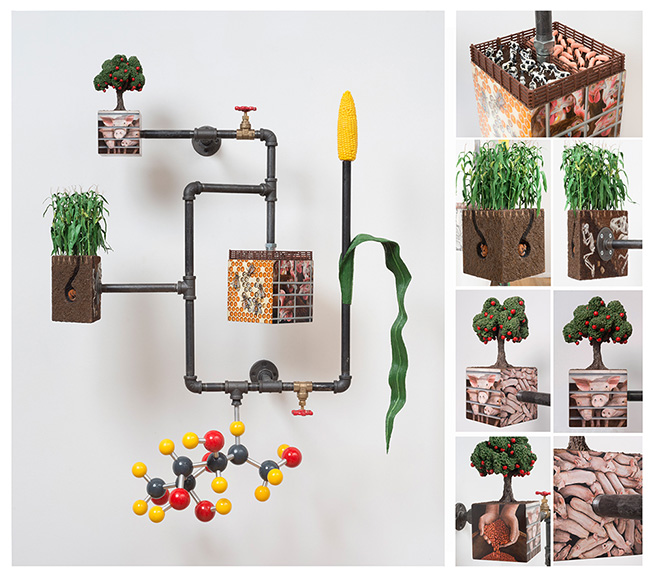
Victoria Fuller, Farm Factory, 2014
Wood, Epoxy Clay, Wooden Cube, Gas Pipe, Acrylic, Resin, Found Objects, Paper, Metal Tube
45″ x 34″ x 17″
I enjoyed the playfulness and message in your investigations focused upon environmental systems in your exhibition Nature2 held at the Packer Schopf Gallery In 2014. Can you share with us an overview of the intent of this project?
The work in Nature2 is both a scientific investigation into systems of nature, but also a look into how the systems of man interfere with the systems of nature. In my sculpture, “In My Back Yard” I created a reproduction of a log with a beehive and bees in it. There are pipes and a hose coming from the log and a cube with images of a housing development, a Japanese beetle and red blood cells on it and a ball with mushrooms on a chain hanging from it. Each element is like a piece of the story – The encroachment of the housing development effects natural habitat, pesticides kill the Japanese beetles (an invasive species) but poison the environment, and red blood cells make up the fluid running in human and animal veins, alike, pointing to the importance of all living things.
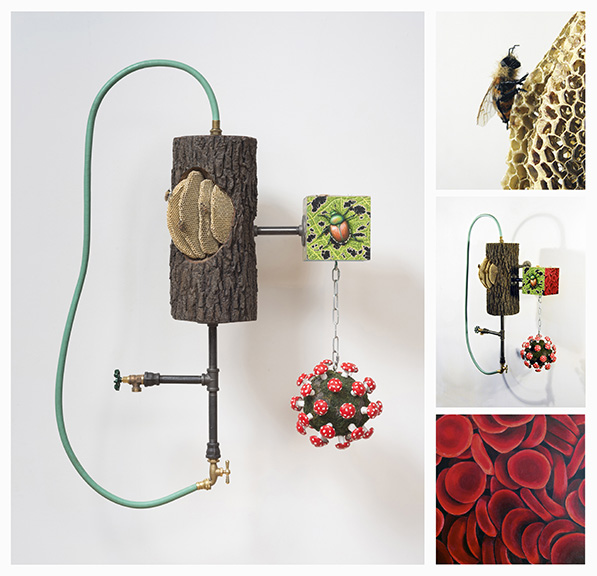
Victoria Fuller, In My Back Yard, 2014
Epoxy Clay, Wooden Cube, Gas Pipe, Garden Hose, paper, wire, acrylic, mylar, flocking
45 1/2″ x 32″ X16″
You recently presented the sculpture Going Nuts at Waubonsee Community College in Sugar Grove, Illinois. I see these cast flax fiber artworks as quality examples of your belief in the artist’s hand being a part of the completed artwork. Why do you see this personal touch as relevant in an age where artists frequently use assistants or other means to produce their work?
I am one of those artists that use assistants too. I created the peanut form in clay and I had my assistant copy that form, to make a similar one like it in clay, then we cast a silicone mold of the clay form. After that I cast the peanut forms with flax fiber, water and wheat paste in the silicone molds and baked them in an oven till they had hardened. I had to make 100 of them, so I had to have an assistant help me create them for the installation deadline. I made sure that the quality of those peanuts was to my specifications. I made some and my assistant made some. I was directing and overseeing the project all along the way. So, to answer your question – quality, and seeing the picture, that I held in my mind, realized in actuality, is important to me. So are skill and craftsmanship, and exemplary executed artwork, both in message and in craftsmanship. I don’t think that these things that I value are necessarily relevant at present, in the art world, but I would like to see it valued more. Conceptual art seems to be what is in the forefront right now, and often does not rely on skillful execution. I have had some of my large public artworks fabricated when the construction is beyond my skill level, but I am the designer, and I oversee the quality, to make sure that it is done right.
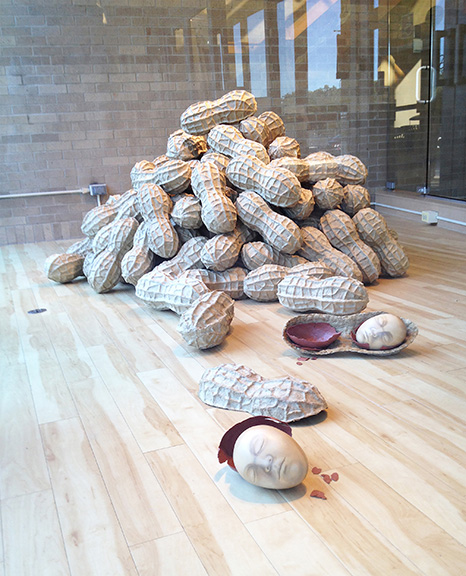
Victoria Fuller, Going Nuts, 2015
Cast flax fiber, epoxy clay, acrylic medium, acrylic paint, 36″ x 96″ x 60″
What you do value most in your art practice?
What I value most is the practice of creating and then seeing my vision realized. Which is very satisfying. Connecting with other creative minds is also is gratifying, to run with my kind. Artists are a particular breed. I don’t think that accountants, insurance salesmen, and bankers get us, unless they are also artists.
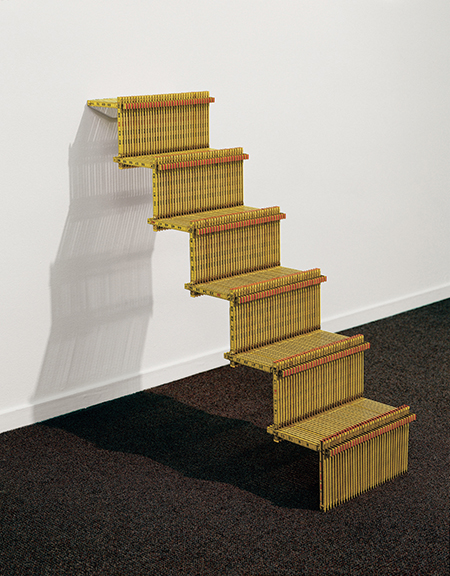
Victoria Fuller, Measured Steps, 2001
Folding rulers, 36″ x 36″ x 13″
What’s the plan for the remainder of 2016? Do you have any specific goals, exhibitions or projects that are in process?
I will be participating in an exhibition in Turin, Italy in July at the Museo Internationale Italia Arte, and when I return I will be working on preparing for another group exhibition of Center Program artists at the Hyde Park Art Center, that opens in July. For the rest of 2016 I will be making work for exhibitions happening in 2017, for The Ukrainian Institute of Modern Art, The Lubeznik Center for the Arts, and the Union League Club.
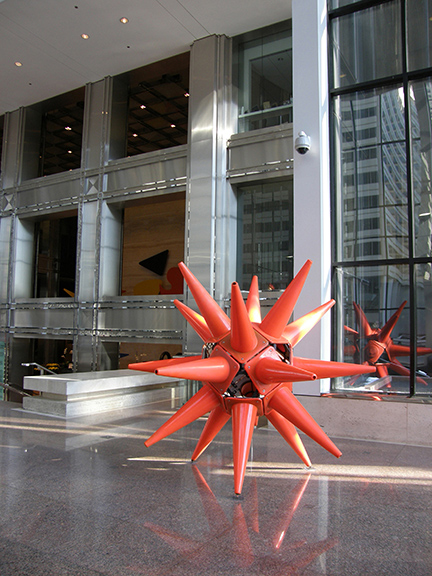
Victoria Fuller, Safety Star, 2003
Traffic safety cones, steel, aluminum, 108″ diameter
For additional information on the artwork of Victoria Fuller, please visit:
Victoria Fuller – http://victoriafullerart.com/
Art World Chicago – https://artworldchicago.com/victoria-fuller/
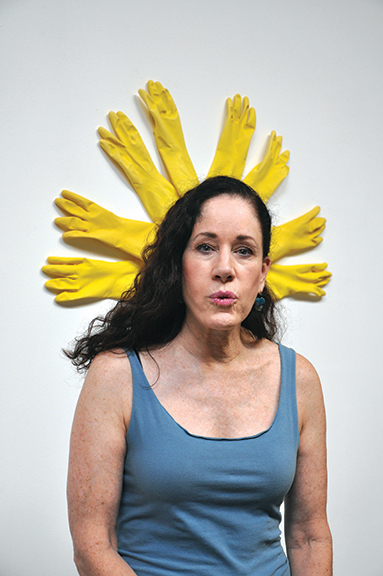
Victoria Fuller, sculptor, Chicago, IL, 2016
Artist interview and portrait by Chester Alamo-Costello


